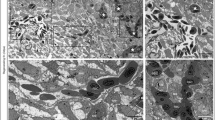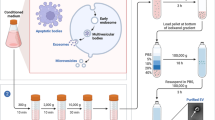Abstract
Re-epithelization and the formation of a granulation tissue consisting of inflammatory cells, newly formed blood vessels, and fibroblasts embedded in a loose collagenous extracellular matrix, are critical events occurring during wound healing. In this study, utilizing the chick embryo chorioallantoic membrane (CAM) as an in vivo model of wound healing, we investigated the role of endogenous and exogenous fibroblast growth factor-2 (FGF-2) in the wound healing reparative processes. The results showed that: (1) neutralizing anti-FGF-2 antibodies (400 ng/embryo) decreased significantly the rate of wound healing (occurring only in 25% of specimens) when applied close to the edge of the wound, causing a significant decrease of microvessel and fibroblast density, and of an inflammatory macrophage infiltrate in the wounded area; (2) conversely, the application of exogenous recombinant FGF-2 (1.0 μg/embryo) greatly accelerated the wound repair occurring approximately 24h earlier than in untreated CAMs, stimulating angiogenesis, fibroblast proliferation, and macrophage infiltration. These findings demonstrate the role of FGF-2 in wound healing of the CAM and suggest that CAM, usually employed as an in vivo assay to study angiogenesis, can also be utilized as an in vivo model for the easy, rapid, and economic screening of molecules potentially able to affect the wound healing process.
Similar content being viewed by others
References
Cohn IK, Diegelman RF, Lindlab WJ (eds). Wound Healing: Biochemical and Clinical Aspects. Philadelphia/London: W.B. Saunders 1992.
Banda WJ, Knighton DR, Hunt TK, Werb Z. Isolation of a non mitogenic angiogenic factor from wound fluid. Proc Natl Acad Sci USA 1992; 79: 7773–7.
Folkman J, Shing Y. Angiogenesis. J Biol Chem 1992; 267: 10931–4.
Brown LF, Kiang-Teck Y, Berse B et al. Expression of vascular permeability factor (vascular endothelial growth factor) by epidermal keratinocytes during wound healing. J Exp Med 1992; 176: 1375–9.
Nissen NN, Gamelli RL, Polverini PJ et al. Basic fibroblast growth factor mediates angiogenic activity in early surgical wounds. Surgery 1996; 119: 457–65.
Nissen NN, Polverini PJ, Koch AE et al. Vascular endothelial growth factor mediates angiogenicactivity during the proliferative phase of wound healing. Am J Pathol 1998; 152: 1445–542.
Ribatti D, Vacca A, Roncali L et al. The chick embryo chorioallantoic membrane as a model for in vivo research on angiogenesis. Int J Dev Biol 1996; 40: 1189–97.
Ribatti D, Vacca A, Ranieri G et al. The chick embryo chorioallantoic membrane as an in vivo wound healing model. Path Res Pract 1996; 192: 1068–72.
Tsubai R, Rifkin DB. Recombinant basic fibroblast growth factor stimulates wound healing in healing-impaired db/db mice. J Exp Med 1990; 172: 245–51.
Greenhalgh DG, Sprugel KH, Murray MJ et al. PDGF and FGF stimulate wound healing in the genetically diabetic mouse. Am J Pathol 1990; 136: 1235–46.
Schuschereba ST, Bowman PD, Ferrando RE et al. Accelerated healing of laser-injured rabbit retina by basic fibroblast growth factor. Invest Ophthalmol Vis Sci 1994; 35: 945–54.
Szabo S, Folkman J, Vattay P et al. Accelerated healing of duodenal ulcers by oral administration of a mutein of basic fibroblast growth in rats. Gastroenterology 1994; 106: 1106–11.
Nakamura T, Hara Y, Tagawa M et al. Recombinant human basic fibroblast growth factor accelerates fracture healing by enhancing callus remodeling in experimental dog tibial fracture. J Bone Miner Res 1998; 13: 942–9.
Broadley K, Aquino A, Woodwards S et al. Monospecific antibodies implicate basic fibroblast growth factor in normal wound repair. Lab Invest 1989; 61: 571–5.
Hu DE, Hori Y, Presta M et al. Inhibition of angiogenesis in rats by IL-1 receptor antagonist and selected cytokine antibodies. Inflammation 1994; 18: 45–58.
Ortega S, Ittmannn M, Tsang SH et al. Neuronal defects and delayed wound healing in mice lacking fibroblast growth factor 2. Proc Natl Acad Sci USA 1998; 95: 5672–7.
Ribatti D, Urbinati C, Nico B et al. Endogenous basic fibroblast growth factor is implicated in the vascularization of the chick embryo chorioallantoic membrane. Dev Biol 1995; 170: 39–49.
Ribatti D, Nico B, Bertossi M et al. Basic fibroblast growth factor-induced angiogenesis in the chick embryo chorioallantoic membrane: An electron microscopic study. Microvasc Res 1997; 53: 187–90.
Ribatti D, Gualandris A, Bastaki M et al. New model for the study of angiogenesis and antiangiogenesis in the chick embryo chorioallantoic membrane: The gelatin sponge/chorioallantoic membrane assay. J Vasc Res 1997; 34: 455–63.
Moloney WC, Mc Pherson K, Fliegelman L. Esterase activity in leucocytes demonstrated by the use of naphthol AS-D-chloroacetate substrate. J Histochem Cytochem 1960; 8: 200–7.
Ribatti D, Bertossi M, Nico B et al. Role of basic fibroblast growth factor in the formation of the capillary plexus in the chick embryo chorioallantoic membrane. An in situ hybridization, immunohistochemical and ultrastructural study. J Submicrosc Cytol Pathol 1998; 30: 127–36.
McNeil PL, Muthukrishan L, Warder E, D'Amore PA. Growth factors are released by mechanical wounded endothelial cells. J Cell Biol 1989; 109: 811–22.
Bashkin P, Doctrow S, Klagsbrun M et al. Basic fibroblast growth factor binds to subendothelial extracellular matrix and is released by heparitinase and heparin-like molecules. Biochemistry 1989; 28: 1737–43.
Villaschi S, Nicosia RF. Angiogenic role of endogenous basic fibroblast growth factor released by rat aorta after injury. Am J Pathol 1993; 143: 181–90.
Tsubai R, Rifkin DB. Recombinant basic fibroblast growth factor stimulates wound healing in healing-impaired db/db mice. J Exp Med 1990; 172: 245–51.
Tsuji S, Kawano S, Higashi T et al. Gastric ulcer healing and basic fibroblast growth factor: Effects of lansoprazole and famotidine. J Clin Gastroenterol 1995; 20(S2): S1-S4.
Buntrock P, Jentzsch KD, Heder G. Stimulation of wound healing using brain extract with fibroblast growth factor activity. Exp Pathol 1982; 21: 46–53.
Buckley A, Davidson JM, Kamerath CD et al. Sustained release of epidermal growth factor accelerates wound repair. Proc Natl Acad Sci USA 1985; 82: 7340–4.
Linch SE, Colvin RB, Antoniades HN. Growth factors in wound healing: Single and synergistic effects on partial thickness porcine wounds. J Clin Invest 1989; 84: 640–6.
McGrath MH, Emery JMI. The effect of inhibition of angiogenesis in granulation tissue on wound healing and the fibroblast. Ann Plast Surg 1985; 15: 105–22.
Bikfalvi A, Klein S, Pintucci G, Rifkin DB. Biological roles of fibroblast growth factor-2. Endocrine Rev 1997; 18: 26–45.
Kon K, Fujiwara T. Transformation of fibroblasts into endothelial cells during angiogenesis. Cell Tissue Res 1994; 278: 625–8.
Montesano R, Pepper MS, Orci L. Paracrine induction of angiogenesis in vitro by Swiss 3T3 fibroblasts. J Cell Sci 1993; 105: 1013–24.
Kuzuya M, Kinsella JL. Induction of endothelial cell differentiation in vitro by fibroblasts-derived soluble factors. Exp Cell Res 1994; 251: 310–8.
Sato N, Sawasaki Y, Senoo A et al. Development of capillary networks from rat microvascular fragments in vitro: The role of myofibroblasts cells. Microvasc Res 1987; 33: 194–210.
Villaschi S, Nicosia RF. Paracrine interactions between fibroblasts and endothelial cells in a serum-free coculture model. Modulation of angiogenesis and collagen gel contraction. Lab Invest 1994; 71: 291–9.
Knighton DR, Hunt TA, Schenenstuhl H et al. Oxygen tension regulates the expression of angiogenesis factor by macrophages. Science 1983; 221: 1283–5.
Leibovich SJ, Wiseman DM. Macrophages, wound repair and angiogenesis. In Growth Factors and Other Aspects of Wound Healing: Biological and Clinical Implications. New York: Alan R Liss 1988: 131–45.
Sunderkotter C, Steinbrink K, Goebeler M et al. Macrophages and angiogenesis. J Leukoc Biol 1994; 55: 410–22.
Gabbiani G, Montandon D. Reparative processes in mammallian wound healing: The role of contactile phenomena. Int Rev Cytol 1977; 48: 187–219.
Baird A, Mormede P, Bohlen P. Immunoreactive fibroblasts growth factor in cells of peritoneal exudate suggests its identity with macrophage-derived growth factor. Biochem Biophys Res Commun 1985; 126: 358–64.
Wempe F, Lindner V, Augustin HG. Basic fibroblast growth factor (bFGF) regulates the expression of the CC chemokine monocyte chemoattractant protein-1 (MCP-1) in autocrine-activated endothelial cells. Arteriosclerosis Thromb Vasc Biol 1997; 17: 2471–8.
Author information
Authors and Affiliations
Rights and permissions
About this article
Cite this article
Ribatti, D., Nico, B., Vacca, A. et al. Endogenous and exogenous fibroblast growth factor-2 modulate wound healing in the chick embryo chorioallantoic membrane. Angiogenesis 3, 89–95 (1999). https://doi.org/10.1023/A:1009049932252
Issue Date:
DOI: https://doi.org/10.1023/A:1009049932252




